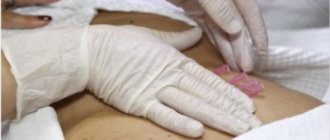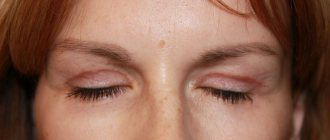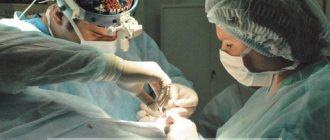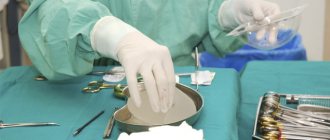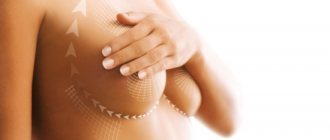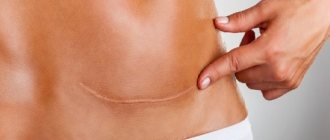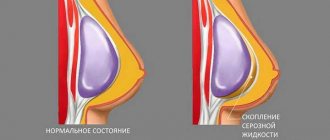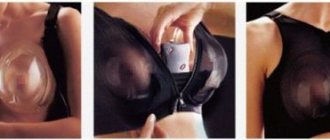Types of seams
In the field of modern surgery, several types of sutures are used.
Surgical
They belong to the older generation. Currently, it is used only when it is necessary to tighten a large surgical field, if microsurgical devices are not able to contain the spreading of tissues.
High-quality sutures applied after mammoplasty are the basis for an aesthetically pleasing result of the operation.
Several types of suture material are used: surgical, cosmetic (lavsan, catgut, vicryl), fixation with staples, invisible.
They try to place the sutures in such a way that after healing the scar is invisible, usually in the areola area or inframammary fold.
In the field of plastic surgery, such sutures are used in rare cases and, as a rule, only for the purpose of primary fusion of tissue structures, when there is a need to create a field for secondary surgical intervention.
The advantage of locating the scar on the border of the areola is not that the latter has folds, but in two points.
The areola is restored very quickly (a feature of this tissue). If the scar is dark, it will be disguised as an areola; if it is light, then it will be disguised as the skin.A transareolar incision is rarely used.
Cosmetologist, dermatologist, trichologist
Kalinina Olga Alexandrovna
4 years of experience
Cosmetic
This is one of the most common options for tissue fusion. Such a suture can be performed not only at the final stage of the operation, but also as an intermediate fixation.
The main advantage of this type is that it does not require further traction, resulting in no trauma to the healing scar.
Soluble threads are classified into several types.
Lavsan
It takes two to eight weeks to resolve.
Catgut
Such threads dissolve within 30-120 days. The time will depend on indicators such as the thickness of the material, the nature of the surgical intervention, and the size of the field.
Vicryl
This is a type of catgut thread. It is used in most cases to tighten deep postoperative fields, since the composition also contains bioglue. The resorption period takes up to 2.5 months.
Fixation with staples
This surgical method is preferred for closed areas of the body. For the manufacture of staples, a chromium-nickel or zirconium alloy is used. Apply it along the entire length of the seam, fixing the middle and edges.
The main task of the surgeon in this case is to align the edges of the incision as accurately as possible.
The main disadvantages of such a splice:
- slow healing of the scar after mammoplasty;
- high probability of improper fusion or spreading of tissues;
- imperfect appearance of scars .
This method has recently begun to be used only when performing small strip interventions that exclude the endoscopy method.
Invisible
This is a more common type of seam. For fusion in such situations, a special bioglue with a fibrin base is used.
Since with this method there is an immediate reaction of the glue with blood plasma, when making a seam, one should not allow the edges to warp, overlap them, or form fixing nodes.
What to pay attention to
Breast restoration after mammoplasty largely depends on the individual characteristics of the patient’s body, metabolic rate, general health and other factors. Therefore, the periods listed above can shift down or up, and the rehabilitation will proceed normally. But in some cases, you should contact your doctor without waiting for your scheduled consultation date.
Contact your surgeon if you experience any of the following symptoms:
- increased body temperature, which persists 7–10 days after surgery;
- discharge from sutures;
- significant changes in the scars (severe redness, their bulge, etc.);
- marked deterioration in health, lack of recovery 2–3 weeks after surgery.
In most cases, such symptoms indicate an incorrect recovery period or are associated with the individual characteristics of the situation. But as a precaution, you should contact your doctor and get specialist advice.
Where are they located?
If it is necessary to enlarge or correct the mammary glands, the surgeon must solve the following problems:
- improve the existing form ;
- tighten your chest;
- reduce or increase to the required volume .
Moreover, for each case there must be a competent comparison of the client’s wishes and the possibility of surgical intervention. In addition, you need to perform the operation as correctly as possible and make post-operative marks less noticeable.
Why can our articles be trusted?
We make health information clear, accessible and relevant.
- All articles are checked by practicing doctors.
- We take scientific literature and the latest research as a basis.
- We publish detailed articles that answer all questions.
The location of the seams, which should not cause discomfort and be less noticeable, also plays an important role in mammoplasty.
During breast plastic surgery, specialists use one of the following access methods.
Periareolar
The scar is hidden on the areola of the nipple. Since in most cases it has a folded surface, it can only be noticed upon close examination.
This method is not suitable for patients who are planning to conceive a child or breastfeeding, due to the likelihood of damage to the milk ducts during surgery.
Axillary
The sutures run along the line of the large mammary gland muscle in the armpit area. The disadvantage of this method is that the scar may bleed frequently. In addition, the risk of infection in the wound increases, since the sweat glands are located as close to it as possible.
Submammary
The passage of the seams is marked in the substernal fold, which camouflages them well from prying eyes. The disadvantage of this placement of the seam is the presence of discomfort when wearing a bra with a dense core and the likelihood of infection.
Transareolar
The passage of the seam along the diameter of the areola is marked with a transverse line. This is one of the more traumatic varieties. But it is worth noting that the scar after it remains almost invisible.
Treatment of keloid scars
Let's return for a moment to keloids, that is, incorrectly, roughly fused places of incisions. Sometimes this “scalpel mark” is mistakenly called a colloid scar. Colloids are dispersed systems (suspension, gel). They are used to prevent scar formation (for example, Contractubex gel).
Keloids require specific treatment. It’s a little late to ask how to smear such “marks.” In this case, “poultices” will not get rid of it. Although the above gel belongs to the category of proteolytics, it can only help if your scar is “young”, and even here its capabilities are limited. Physiotherapeutic and surgical measures are used to correct old scars:
- laser correction;
- cryodestruction;
- electrophoresis with drugs that promote scar resorption (Lidaza, Karipazim);
- placement of a silicone plate on the affected surface (suitable only for recently formed keloids);
- phonophoresis;
- hormone therapy (glucorticoids are administered).
For old and very rough scars, they are excised. The procedure is carried out step by step and very carefully, in order to avoid the formation of a new rough “trace” of surgical intervention.
With this we say goodbye to you, but only until the next article. Share our information with your friends via social networks, and you will help them answer many important questions.
How to properly care
To remove the scar in the shortest possible period of time, you must strictly adhere to some of the specialist’s instructions.
First of all, seams require regular treatment with special means. To do this, you will need an antiseptic solution (hydrogen peroxide 3% concentration or medical ethanol is possible), a processing material (a bandage is best), as well as a binding material - an adhesive plaster or wide-band adhesive tape.
In addition, during the rehabilitation period it is necessary to wear special underwear, avoid heavy physical activity, do not make sudden movements with your hands and do not lift heavy objects.
Only by carefully following all the doctor’s recommendations can you minimize the risks that the suture will not heal properly.
Indications for breast augmentation
- unsatisfactory breast size;
- breast asymmetry;
- ptosis caused by breastfeeding/sudden weight loss;
- excess adipose tissue;
- excess glandular tissue;
- unsatisfactory nipple shape.
Plastic surgery using implants is indicated for reconstructive breast correction - after removal of tumors or a complete mastectomy. Thus, the operation is not only aesthetic in nature. It can also be performed for medical reasons.
Contraindications for mammoplasty of the mammary glands
- early age (up to 18);
- period of pregnancy and lactation;
- problems with blood clotting;
- liver diseases;
- cardiovascular and endocrine diseases;
- diabetes;
- oncology;
- respiratory system diseases;
- infectious and viral diseases;
- psychical deviations.
If the results of preoperative tests are unsatisfactory, the operation is postponed to a later time or cancelled.
Two weeks before surgery, you need to stop taking blood thinners and hormonal medications.
Symptoms of complications
Changes in the appearance of sutures are often observed when implants are rejected. In this case, the central area of the wound surface begins to fester.
There is redness and swelling of the soft tissues located near the suture. A pulsation appears, and the temperature of the skin rises in that area. If such signs appear, immediate medical attention is required.
If the seams are not fused correctly, breast deformation will be visually noticeable. Symptoms of the inflammatory process are usually absent.
When infected, the clinical picture will depend on the time at which it occurred. So, if the infection was caused by a pathogenic microorganism during surgery, then the process will be accompanied by chills, headaches, bouts of vomiting, weakness, and an increase in body temperature.
When infected in the postoperative period, inflammation within the areola, the appearance of melted ends of the suture, and deformation of the bends are noted.
What examinations need to be completed before the test procedure?
If your doctor is planning cosmetic correction under local anesthesia, you will need to undergo several basic tests before the procedure:
- General clinical blood test (complete + platelets)
- Coagulogram (blood clotting time, bleeding time, INR, prothrombin index, fibrinogen, APTT)
- Biochemical blood test: ALT, AST, bilirubin, cholesterol, urea, creatinine
- Blood sugar (glucose) test
- Tests for hepatitis B, hepatitis C, HIV, syphilis
Is it possible to remove it after?
It is not possible to remove scars that may remain after mammoplasty on your own. To eliminate this problem, cosmetic or plastic correction is performed, the main task of which is to smooth out the scar.
Sutures after mammoplasty require some time to heal. This process is lengthy and requires a responsible approach. To maintain the aesthetic appearance of the operated area and reduce the risk of complications, it is necessary to strictly follow all recommendations of specialists during the rehabilitation period.
Types of breast enlargement implants
For breast enlargement, silicone implants of various volumes (1 size is equal to 120 ml) and shapes are used: round or teardrop-shaped (anatomical).
- The mammoplasty operation with the installation of round implants forms voluminous, raised breasts with regular rounded contours. In nature, this shape of the mammary glands (“apple”) is quite rare, so after breast augmentation, the breast may look less natural than with the installation of anatomical implants. But this type of implant is suitable for correcting mild ptosis of the mammary glands without additional lifting.
- Teardrop-shaped implants reproduce the most common shape of the mammary glands: they resemble a cone in appearance. With them, the breast acquires a fuller lower pole with a smooth descent to it, characteristic of a natural bust. Sometimes only the use of implants of different volumes allows the existing asymmetry to be corrected.
In various cases, your surgeon may recommend implants with a smooth or textured surface.
- Smooth round models are suitable for installation through the axillary (transaxillary) approach.
- Anatomically shaped models with a textured surface are often chosen for breast augmentation through an access under the mammary gland (submammary), which allows you to achieve a beautiful natural result.

